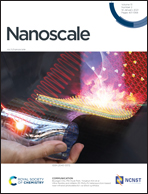A visible light-triggered artificial photonic nociceptor with adaptive tunability of threshold†
Abstract
An artificial photonic nociceptor that can accurately emulate the activation of a human visual nociceptive pathway is highly desired for the development of advanced intelligent optoelectronic information processing systems. However, the realization of such an artificial device needs sophisticated materials design and is pending to date. Herein, we demonstrate a visible light-triggered artificial nociceptor, with a simple ITO/CeO2−x/Pt sandwich structure, that can well reproduce the pain-perceptual characteristics of the human visual system. The abundant oxygen vacancies in the CeO2−x layer account for visible light activation, and the notable built-in electric field due to work function difference of the two electrodes enables the device to work even in a self-powered mode. Key nociceptive characteristics, including threshold, no adaptation, relaxation, and sensitization, are realized in the device and are attributed to the oxygen vacancy-associated electron trapping and detrapping processes within the CeO2−x layer. More importantly, the threshold light intensity to activate the device can be readily manipulated using a sub-1 V external voltage, resembling the ambient luminance-dependent tunability of threshold of the human visual system. This work opens up a new avenue towards the development of next-generation intelligent and low-power perceptual systems, such as visual prostheses, artificial eyes, and humanoid robots.



 Please wait while we load your content...
Please wait while we load your content...